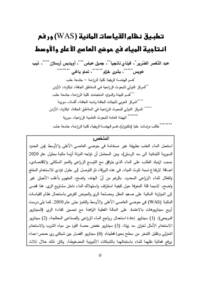تطبيق نظام القياسات المائية (WAS) ورفع انتاجية المياه في حوضي العاصي الاعلى والأوسط. WEAP modeling-based study of Water Accounting System and levels of water productivity in the Upper and Middle Orontes River Basin.

Authors:
Freshwater used unsustainably in the upper and midmost Orontes basin (from Syrian - Lebanese borders to Rastan dam). In Syria country, water predicted to become scarce by 2020 due to demand continuing to grow in parallel with increased agriculture production, increased pollution, population, and economic growth. In this paper, solutions have to be devised to make a substantially more efficient and productive use of a shrinking water supply in agriculture. Although the target is clear, the means are oftentimes not straightforward. In particular, lack of knowledge of how water is used and depleted within irrigation projects. This has leaded to the water balance at field, irrigation service and sub basin levels by using Water Accounting System (WAS) in the upper and midmost Orontes basin and prediction until 2050. Four scenarios were studied depending on the actual situation (RF) with improving the irrigation efficiency: (1) Reuse of reclaimed agricultural and industrial water returns, (2) Optimum exploitation of Zeita reservoir, (3) The reducing of the per capita share of drinking water and minimizing evaporation from the surface of Kattenieh Lake, and (4) Separation between Homs-Hama networks and raising their water conveyance efficiency by exchanging them with pressured pipe networks. The aforementioned scenarios were through three cases of climate changes (normal, dry and very dry years). The results are visualized as graphs, maps and tables, and showed that the upper Orontes basin is closed basin in the current status specially in dry months. however, by application of studied scenarios above, it converts to an open basin in the dry years compared to the midmost Orontes basin, and keeps closing basin in the case of very dry years. By application of the first three scenarios, the critical point (water deficiency) will disappear with obtaining surplus comparing with (RF), to achieve water needs of Homs-Hama networks (third priority) in cases of normal and dry years. Also, we will promote agricultural water productivity better than farmer method in the target area. While the fourth scenario can help highly in minimizing the gap between supply and demand till 2050 in the third case.
استعمل الماء العذب بطريقة غير مستدامة في حوضي العاصي الأعلى والأوسط (من الحدود السورية اللبنانية الى سد الرستن) ، ومن المحتمل أن تواجه الدولة أزمة مائية بحلول عام 0202 بسبب ازدياد الطلب على الماء الذي يترافق مع التوسع الزراعي والنمو السكاني والأقتصادي، اضافة لأرتفاع نسبة تلوث المياه. في هذه الورقة، تم التوصل إلى حلول تؤدي لستخدام المنتج والفعال للماء الزراعي المحدود. بالرغم من أن الهدف واضح، المفهوم بأغلب الأحيان غير واضح، لاسيما قمة المعرفة حول كيفية استنزاف واستهلاك الماء داخل مشاريع الري. هذا قضى إلى الموازنة المائية على صعيد الحقل ومصلحة الري والحوض الفرعي باستعمال نظام القياسات المائية WAS )) في حوضي العاصي الأعلى والأوسط والتنبؤ حتى عام 2050 .كما يلي درست أربع سيناريوهات بالاعتماد على الحالة الفعلية الراهنة مع تحسين كفاءة الري (السيناريو المرجعي ): (1) سيناريو إعادة استعمال رواجع الماء الزراعي والصناعي المعالجة، (2) سيناريو الاستخدام الأمثل لخزان سد زيتا، (3) سيناريو خفض حصة الفرد من مياه الشرب والاستخدام المنزلي وتقليل التبخر من سطح بحيرة قطينة، (4) سيناريو الفصل بين شبكتي ري حمص-حماه ورفع فعالية نقلهما للماء باستبدالهما بالشبكات الأنبوبية المضغوطة. وكان ذلك خلال ثلاث حالات للتغيرات المناخية (السنوات الطبيعية، الجافة، الجافة جدا). صيغت النتائج على شكل مخططات وخرائط وجداول وأظهرت ان حوض العاصي الأعلى مغلق في الحالة الراهنة ولاسيما في أشهر الجفاف، وبتطبيق السيناريوهات أعلاه يتحول الى حوض مفتوح حتى في حالة السنوات الجافة جدا حيث بتطبيق السيناريوهات الثلاثة الاولى نتمكن من تفادي العجز المائي ونحسن من انتاجية الماء الزراعي بشكل افضل بشكل أفضل من طريقة المزارع في المنطقة المستهدفة خلال الحالة الأولى والثانية. في حين نتمكن بالسيناريو الرابع من تقليل الفجوة بين العرض والطلب بشكل كبير والسنوات جافة جدا.
